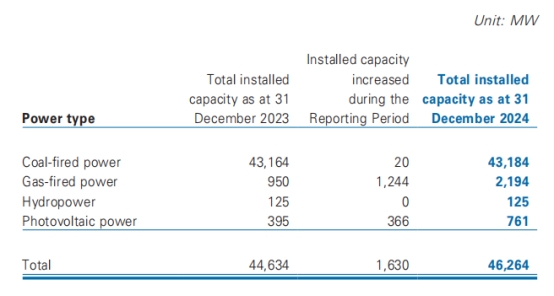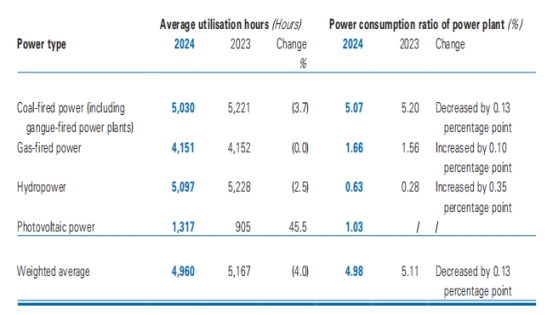In 2024, the Group continued to optimise the operation mode of its units, maintain the safe and stable operation of its units and enhance its ability to maintain the peak supply of electricity. The Group carefully studied the supply and demand situation in the power market and accurately implemented power marketing strategies to effectively achieve stable power generation with increased output. The Group realised a total power output dispatch of 210.28 billion kWh throughout the year, accounting for 2.1% of 9,852.1 billion kWh of the total power consumption of the society in the corresponding period.The average utilisation hours of coal-fired generators of the Group reached 5,030 hours for the year 2024, 402 hours higher than the national average utilisation hours of 4,628 hours for coal-fired generating units with the installed capacity of 6,000KW and above.
The Group accelerated the construction of new power systems and promoted the green and low-carbon transformation and development of thermal power. It strategically deployed supportive power supply, scientifically planned the Huizhou Phase II gas power project, the first in China to adopt domestically developed BIM technology and advanced the construction of ongoing projects such as Jiujiang Phase II, Beihai Phase II, Qingyuan Phase II. It also commenced high-standard construction of thermal power projects, including Dingzhou Phase III, Cangdong Phase III. The Group intensified the “three simultaneous technical reforms” (三改聯動) of coal-fired power units, completing the transformation of a total of six units of Cangdong Power Plant and other power plants for heat supply, with a new heating capacity of 9,620 MW; completing the transformation of a total of nine units of Jiujiang Power Plant and other power plants for flexibility, with a new peak-adjusting capacity of 740 MW; and completing the energy-saving and carbon-reducing transformation of a total of 21 units of Taishan Power Plant and other power plants. The Group’s standard coal consumption for thermal power supply dropped to 292.9 g/kWh in 2024 (2023: 294.9 g/kWh), a year-on-year decrease of 2.0 g/kWh.

